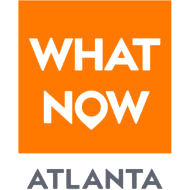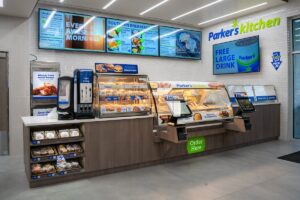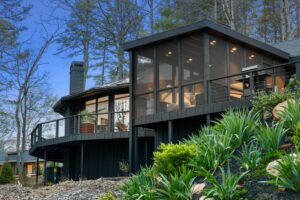Noted urban planning writer Jonathan Lerner weighs in.
[Editor’s note: Jonathan Lerner’s work has been published in Landscape Architecture, The Architect’s Newspaper, Metropolitan Home, Metropolis, and The Washington Post. He wrote this op-ed specifically for What Now Atlanta.]
Sign up now to get our Daily Breaking News Alerts
Unless you’ve been wearing a blindfold, you surely will have noticed the recent completion of Novare Group’s glassy Skyhouse Midtown condo tower at 12th and Peachtree. Or maybe not. One glassy condo tower can look much like another, especially in a district where high-rises are exploding skyward as fast as fireworks and most are just as gaudy. The fact is, it takes thoughtful design to make a building both distinctive itself and appropriate for its site and surroundings.
Actually, Novare Group has taken the cookie-cutter approach to a new level. It has other Skyhouse projects in various stages of development on 6th Street in Midtown Atlanta, and in Dallas, Houston, Austin, Orlando and Charlotte. They share more than a brand name. The buildings, from the outside at least, appear virtually identical. (There’s a Skyhouse planned for Buckhead, too, also the same but for a different roofline.) In fact, the renderings on the Midtown project’s website and for the Dallas, Austin and Orlando projects on Novare’s corporate website are the very same image – right down to the clouds, trees and buildings in the background. And you thought they grew palm trees in Orlando.
The country is already amply furnished with suburban corridors that are mind-numbingly indistinguishable. Those aesthetic wastelands are propelling people back into city centers. Are the repopulated city centers now to become interchangeable too? Isn’t there something different about the climates, terrains and cultures of places like Orlando, Austin and Atlanta that ought to be reflected in the architecture their citizens are obliged to live with?
It’s too easy, though, to demonize Novare for saddling Atlanta with three of these rubber-stamp structures about which the nicest thing to say is that they’re utterly forgettable. Novare has done excellent projects in the past, including the restoration and repurposing of the landmark Biltmore Hotel on West Peachtree Street, and the urbane and energizing Metropolis condominiums on Peachtree at 8th. But Novare is a developer. And as Atlanta’s dispiritingly banal skyline and suburbs illustrate, developers’ principal concern is rarely aesthetic.
So somebody else has to ensure that what gets built is pleasing to look at and reflects the character of the community rather than leaching the community of personality. Recent changes to Atlanta’s zoning regulations that require ground level retail and pedestrian-friendly streetscape design were an important step toward making the city more livable. Now what about the way buildings look? We live in a culture that privileges private property and entrepreneurialism. But does that give developers the right to clutter the city with ugliness?
Some parts of this city may be past saving. But Atlanta’s intown neighborhoods were built early enough – before automobile culture came to dominate both urban planning and architecture – and were then essentially left alone, so their original character endures. Right now the pressure is on in Midtown. But soon enough it will be imperative to develop densely all through the central neighborhoods, particularly around the Beltline, and especially if its transit component or any other new intown transit is built. The density is a good thing. It’s what will support transit, retail businesses and safe, agreeable neighborhoods. The challenge is to build density so that it gives pleasure rather than offense.






20 Responses
Novare is to architecture what painting by numbers is to art. The dispiriting part about this is that there’s nothing we can do. There are no city ordinances or architectural review boards that can stop companies like Novare from “archi-torturing” us. If the city is to become as great as its cheerleaders say we have to have laws that teach developers some manners.
The cookie-cutter architecture is disappointing. However, the real travesty is the suburban mall parking decks built along what should be engaging sidewalk and street frontages (see the SW corner of Juniper at 7th). Why would a developer squander such valuable real estate? 7th and Juniper could, and should, have been lined with dynamic, appealing, unique, engaging sidewalk frontage that would attract Atlanta’s rock star chefs or neighborhood-oriented shops. It would have increased the marketability of their own tower and the Loudermilk residential tower proposed for the Starbucks corner. It would have connected the thriving and diverse residential neighborhood to the east with Peachtree. It could have incorporated granite blocks, resembling the wall that was on that corner, and hidden the deck behind the sidewalk frontage, comparable to what the Dakota did when it was built across Juniper. Instead, what should have been the front door to the project, and an integral part of a vibrant streetscape, was made the back door, with some compromise token retail frontage jammed into a nasty deck that looks like a jail. A lose-lose-lose-lose for the neighborhood, the City, urban planning, and even Novare.
I’m pretty sure the SW Corner of Juniper at 7th is getting an “Intown” Ace Hardware. I realize the building itself is a parking deck, but at street level it is a side walk experience and walking by it 5-10 times a week I don’t really notice there’s not a high-rise on top.
One additional thing this type of land-use allows is for each of these buildings, with their floor to ceiling windows, to not be staring directly at another unit in the building across the street. It’s only a matter of time before something goes up on the NW Corner of Juniper & 7th.
Beauty is in the eye of the beholder. I don’t particularly find these buildings ugly, although I’m no fan of their cookie cutter design. I don’t think 3,4 or even 7 of Novare’s designs will define the Atlanta skyline. There’s already many high rises with many different designs and many more are to come. If you look at any skyline in the world you’ll see very many similar, cookie cutter buildings. For example, NYC isn’t all trophy towers with unique designs, there’s large swathes of the city that have very mundane, bland towers that can be found anywhere. Does this ruin the urbanity or the cache of NYC? No, it doesn’t, nor will Novare’s towers.
Mike, I don’t disagree. However, a more effective approach (than trying to get the City to enact meaningful legislation while still preserving a degree of artistic licence for diversity) is to find a way to teach the Novare’s of the world why it is in their best interest to develop land in a manner suitable to its environment. Suburban decks squander prime real estate and place the developer’s own building in a less attractive environment. Unique architecture is a distinguishing feature and can be a marketing tool to increase sales and selling prices. Brilliant architecture can be a legacy and draw national and international attention to the project and the City. Perhaps the teaching/leading function can be a role for Midtown Alliance?
J, I agree somewhat. I don’t find Novare’s buildings particularly unattractive (except for the sidewalk-fronting parking garages). However, New York is so large, with so many other diverse buildings, that it can withstand a lot of ugliness or boring design and still be dynamic. A counterpoint example might be Vancouver. Vancouver is a vibrant city, but it’s large skyline is comprised of mostly bluish/greenish/mirrored glass towers, which is quite uninteresting. It does not diminish Vancouver’s urban vitality, but the skyline could have been so much more attractive. Vibrant architecture enhances not only the skyline, but the streetscape and the user experience. I’d be curious to see if any studies have been done to link the attractiveness (admittedly subjective) of a building and its immediate (one or two blocks) surroundings to its marketability, leaseability, or sales prices.
The city needs to look at the parking requirements. If you have read anything in the last year, it is that more people are choosing not to own a car or drive. We need to stop requiring parking with building. MARTA, bike lanes, shoe leather express, Zipcar, Uber, etc. These are the way of the future.
Agreed. I think the regulations still require 1 parking space per bedroom. I doubt developers will be quick to eliminate them altogether, but that number can probably be reduced, especially in rental apartments.
If the buildings were as awful as you say, they wouldn’t be renting so quickly for such high prices. Unless you believe that most people are idiots, which – let’s be honest – they are. Also keep in mind that some of Atlanta’s grandest failures were the condo buildings designed by celebrity architects. So no wonder Novare is keeping it simple.
I concur with all that the same buildings, repeated over and over, do not make for an international city. Just look at the Miami skyline and you will truly see diversity in architecture. you walk and drive through that city and you are constantly craning your neck to look up at all the buildings and the designs. I understand it costs money to build a whole new building, but if the 1163 West Peachtree is NOT a copycat of the other Skyhouse buildings (and from a real estate broker perspective, it better not have HVAC condensers on the balconies!) they why NOT make it something unique? I’m not a developer, but if I was putting my name on a building, I’d want people entering Midtown or passing through on the Downtown Connector to go, “WOW, look at that building! What is that?” I’ve attended many a Midtown Alliance DRC meeting and seen the committee reject proposals and send the developer back to the drawing board. The parking garage for Skyhouse South is just that. Originally, there was NO retail on the corner of 7th and Juniper, but a pocket park that many objected would be a place for homeless. I recall the developer saying that corner was “not leasable space.” Says who??? Well, no, probably not at the sky-high rates they charge, but offer it at a lower rate and believe you me, someone would lease the space. I’d like to think if the subtle word went out from the Alliance that cookie cutters will be frowned upon, maybe someone will step up to the place. But it probably will not be the Novare assembly line of buildings.
I must briefly comment, I disagree with Marcs comments, humbly however. There is much that a city can do to improve the aesthetics y its urban centers, without placing limiting stipulations on builders and developers that don’t bare economic prudence. The city already has a number of beautification campaigns to address this, its not a matter of skyline sizes, Atlanta has a rather extensive skyline with unique architectural offerings, but there are factors influencing design that have plagued us in the past and is rapidly changing. They being a very conservative lending climate, uncontrollable sprawl, due to a lack of physical barriers and social intolerance of different cultures. We are changing, increased density, confidence from outside firms to invest in projects like buckhead Atlanta, ponce city market and several stunning buildings designs in the pipeline, as the number seven skyline in the country, the best is yet to come, and these are the words of and outsider from California, with all the admirable development in our pipeline there are far too many complaints.
PK, I’m happy that a tenant was found for the space, and Ace should be a good match for that spot. But, the retail space is glaringly jammed into an unappealing deck that sticks out like a sore thumb on that corner. The driveway entrances are unusually wide and the “retail” frontage closest to Starbucks is a faux front that just goes into the deck. The “patio” in the corner is shallow and concrete and very uninviting. There is no excuse for this. Novare did Metropolis one block away. There is a parking deck in the project and you can (barely) see it above the former Tagliatella space. But, neither the 8th, Peachtree, or 9th Street frontages of Metropolis have a visible looming deck and the deck entrance is via a mid-block alley behind the building. Spire has continuous store fronts along 7th, but, if you look hard, you can see there is a deck, recessed from the sidewalk, above/behind the retail/restaurants. The corner with F2O is not dominated by a looming deck! If it could work at Metropolis and Spire, it could work one block away. The new deck shows lack of vision and is an eyesore. And, yes, there will likely be a development on the NW corner of Juniper/7th. My fear is that another developer with lack of vision will mirror Novare’s precedent and totally kill that corner. Thanks to Novare, it will be harder to justify stunning architecture and an engaging space that will be staring across the street at a concrete garage.
Metropolis had the luxury of an alley in the back so they could hide their parking entrance. The entire back of the building is nothing but driveway and wall.
Elijah, I’m not sure you are disagreeing with me. I suggested that better than relying on the city to enact legislation, we should find a mechanism to educate developers to the fact that they themselves benefit from sound urban design and architecture principles. The relationship between a developer and the community does not need to be adversarial. Personally, I’m a fan of the densification of Midtown. I moved here to live in a city, I enjoy walking to a lot of cool places, and it increases my property value. So, my tendency is to support these developments and I think the neighborhood generally shares that opinion. So, we are not fighting these developers, and I’m not sure we need a bunch of new rules. But, it is in all of our interests, including the developers, to ensure that the new developments enhance the built environment, and comport with sound urban design principles. If we can demonstrate to developers that they can achieve a better return on their investment by doing things the “right” way, they will be more inclined to listen and work with us. This, I suggested, may be a role for Midtown Alliance.
Thom, I was one of those opposed to the corner pocket park, less out of fear of urban campers, but more due to the desire to create some prime leasable space. It is disconcerting that a developer who is building so much in Midtown, cannot recognize that a prime corner on a major thoroughfare, at the focal point between a popular and diverse neighborhood and the Peachtree corridor, is leasable space. It is precisely this lack of vision and understanding of the neighborhood that led Novare to build an eyesore garage rather than an attractive asset on that corner. Atlanta has for so long been obsessed with Peachtree Street addresses that any other street frontage, even one block from Peachtree, is considered a back door.
I agree, the building are not the prettiest but I don’t think they are ruining the skyline. At least they’re filling it in a bit, and they do add some street level retail. Although I haven’t seen any retail that is to die for yet, aside from a nail shop or two I’m sure with time it may get better. A lot of skylines have cookie cuter condos that look the same. When you drive into one of my Fav cities, “Toronto”, on the east of the hwy bordering the harbour are several cement condos that look identical. Our skylime is still young so who know what is to come.
Novare has become the Levittown of Midtown Atlanta.
PK, Novare developed Viewpoint and had the rare urban luxury of a master plan for the entire block except the Starbucks corner. There is no excuse that they didn’t have an alley. And, even without an alley, parking could be accommodated underground, behind, or above a well-designed project. Sorry, but a sidewalk-fronting parking garage at that prime location is an unequivocal urban design fail.
been here, done that… http://whatnowatlanta.com/2011/08/29/architectural-feud-designer-challenges-novare-to-a-duel-over-its-proposed-midtown-apartment-highrise/
i still maintain that monstrosity of a parking deck at spring is one of the biggest blights in midtown.
The idea that Atlanta has a beautiful world class skyline that can be “ruined” is way off base to begin with. Let alone ruined by these similar Novare buildings. Every large city has a lot of buildings that look alike. So what? These buildings are a decent design that can be executed profitably while providing the city with some of the density it desperately needs.
What really matters is that residential buildings are replacing sun-baked desolation. If you remember what Midtown used to look like only 15 years ago you will be thrilled with what we’re getting and complain less that we are missing the chance to be like Vienna or Prague or Paris or New York because that chance doesn’t exist yet for this city. It was never on the table. Our options are this, or empty lots doomed to stay empty for eternity because Dewberry or some other speculator from the suburbs is willing to let them sit until he can think of a way to quadruple his investment.
But I admit the complainers are right these buildings absolutely suck at street level. If they weren’t already placed on dead blocks to begin with they’d be called “block killers.” Rather than complaining about what they look like on top or in the middle—and they’re not even that bad looking—we should concentrate on how they engage the street. Viewpoint had to have a massive facelift recently (which took an inexplicably long time) just to go part of the way in correcting this. I guess Novare has to be like most other Southern builders and build everything twice: the first time putting as little thought and effort into it as possible and cutting every corner, and the second time correcting all the problems created by the first approach.